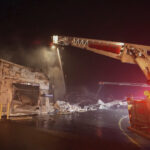Looking back at my Insurance Journal columns over the past 5 years, I found that I wrote at least one column a year about water damage claims. So, before this year runs out, I guess it’s time for another, especially because of a commercial property water damage claim that was recently brought to my attention.
But before we get to that claim, let me provide a quick update about water damage claims. In my April 6, 2021, column, I provided some statistics about water damage claims. The numbers haven’t changed much. Many people think of property insurance as “fire insurance” when the reality is that the leading cause of loss to property is wind and hail, followed by water damage.
And even though the frequency of wind and hail claims is higher than that for water damage, the severity of water damage claims is higher. In that earlier column, I mentioned three recent, at the time, plumbing leak claims, one totaling $540,000 in damages and another with over $200,000 in damages. These may be outliers but the average water damage loss involves five figures in damages, according to ISO.
Most property policies cover water damage arising from a plumbing system leak as long as the damage has not occurred over a period of weeks, months or years. In other words, repeated seepage and leakage is typically not covered, though some policies may cover hidden water damage if the loss is reported promptly upon discovery, proof, once again, that insurance is not a commodity. Regardless, coverage for these types of sudden leakage claims is usually not disputed, though the amount of damage and what needs to be repaired or replaced may be.
But the most common type of plumbing system claim that raises questions about coverage itself involves water damage from a plumbing system that doesn’t involve seepage or leakage. These claims typically result from backup or overflow of water and, in the case of drains and sewer lines, waterborne “debris.” Claim disputes most often involve whether there is backup or overflow and coverage depends on the precise wording of the policy in question.
For example, in my December 7, 2020, column, we examined whether water damage from an unattended running toilet was backup or overflow. Virtually all property policies exclude backup of sewers or drains but overflows are treated differently by some policies. To illustrate, consider the following backup/overflow exclusions in three ISO forms, all of which provide coverage on an open perils (named exclusions) basis:
- ISO HO 00 03 (Coverages A & B open perils homeowners form):
“Water or waterborne material which backs up through sewers or drains or which overflows or is discharged from a sump, sump pump, or related equipment.” - ISO BP 00 03 (BOP policy):
“Water that backs up or overflows or is otherwise discharged from a sewer, drain, sump, sump pump or related equipment.” - ISO CP 10 30 (Special Causes of Loss form):
“Water that backs up or overflows from a sewer, drain or sump.”
Do you see the coverage difference between the homeowners form and the commercial property forms? All of these forms exclude backup and overflow, but they differ in what kind of plumbing equipment is involved in either type of event — backup or overflow.
The homeowners policy only excludes damage from an overflow of a sump, sump pump, or related equipment. Like the homeowners form, the two commercial property forms exclude overflow from sumps, but they also exclude overflow from sewers and drains.
That being said, the overflow of water and debris must originate from within the sewer or drain lines. For example, if a bathtub or sink faucet is accidentally left running and water overflows and causes damage, this is not “overflow” as intended by these exclusions.
The reason this type of claim is covered by these open perils forms is that the water or debris causing damage never enters a drain or sewer line. There is no reverse flow from these parts of the plumbing system. As my earlier column indicated, the same is true for most toilet overflows.
The Commercial Property Claim
This brings me to the commercial property claim I mentioned at the outset of this article.
There is no disagreement between the insurer and insured as to the facts of the loss. A kitchen sink faucet was left running overnight in a church kitchen. The sink drain was reportedly blocked by dishes in the sink, specifically a food storage container and/or an aluminum pan.
The running water never entered the drain from the sink; again, an undisputed fact. The problem is, the damage amounted to over $100,000 but the adjuster limited coverage to $50,000 — the limit of the Water Backup and Overflow Coverage endorsement attached to the policy.
The policy in question is an American Association of Insurance Services (AAIS) form Building and Personal Property Coverage Part CP-12 with causes of loss provided by the AAIS Special Perils Part CP-85 form. The CP-85 form is an open perils causes of loss form, meaning that anything not excluded is covered.
In the adjuster’s letter denying coverage for any damage beyond that covered by the Water Backup and Overflow Coverage endorsement, it states that this is “a specified peril insuring agreement rather than an all-risk policy.” According to AAIS, however, the CP-85 form included in the policy provides coverage on an open perils basis.
The letter asserts that the definition “Specified Perils” says that water damage means “the sudden or accidental discharge or leakage of water or steam as direct result of cracking of a part of the system or appliance containing the water or steam.”
This does not make the coverage named perils. The purpose of the “Specified Perils” definition is to extend coverage for any listed peril if damage arises from certain exclusions that make an exception for ensuing loss due to those perils. This is the same approach used by ISO in the CP 10 30 Special Causes of Loss form.
Unless I’m missing something, the adjuster appears to have a misunderstanding of the application of the CP-85 open perils form, specifically the purpose of the “Specified Perils” definition.
Topics Claims
Was this article valuable?
Here are more articles you may enjoy.



 Florida Bill Advances, Would End Board of Engineers, Other Professional Agencies
Florida Bill Advances, Would End Board of Engineers, Other Professional Agencies  Pet Insurance, Agents Gets a Shorter Leash Under Bill DeSantis Signed Into Law
Pet Insurance, Agents Gets a Shorter Leash Under Bill DeSantis Signed Into Law  NJ Wildfire Update: 50% Contained; High Spread Risk Today; Suspect in Custody
NJ Wildfire Update: 50% Contained; High Spread Risk Today; Suspect in Custody  USI Says Lockton, Former Team Leader Poached Workers, Harmed Client Relations
USI Says Lockton, Former Team Leader Poached Workers, Harmed Client Relations 



